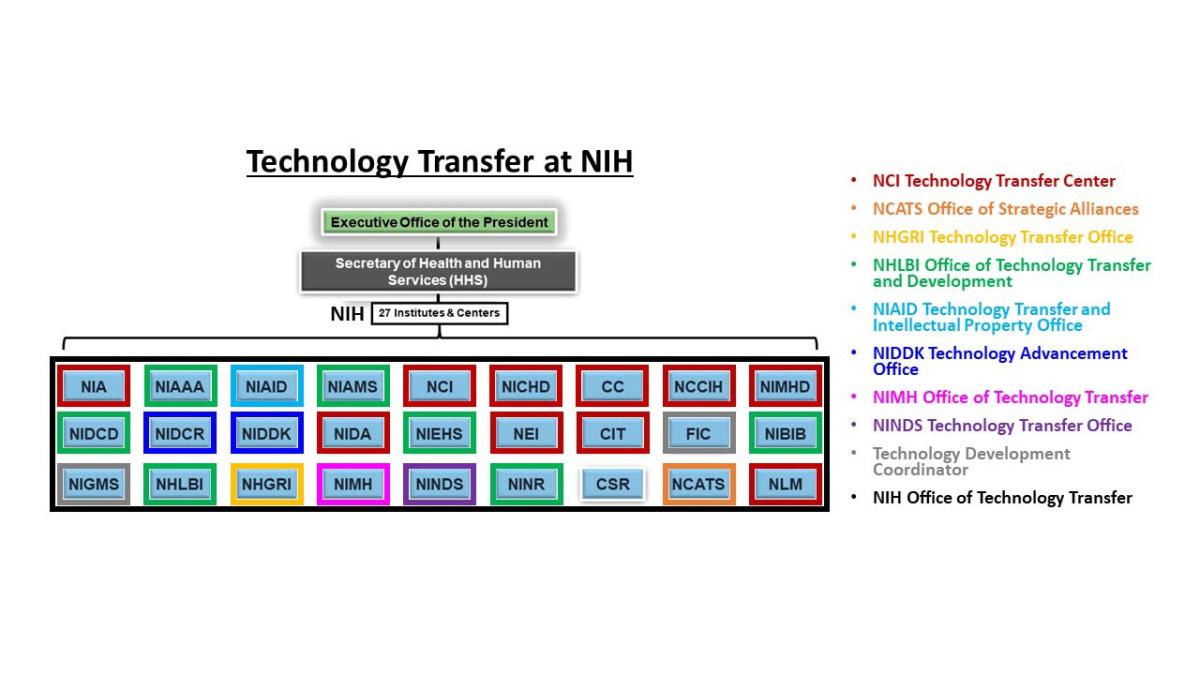News You Can Use: Technology Transfer
How to Disclose and Protect your Research Discovery or Innovation at NIH
So, you have a research discovery or innovation at NIH—now what? Federal researchers are legally required to disclose their discoveries and inventions. NIH technology transfer (TT) professionals across multiple TT offices that serve different institutes and centers assess whether those discoveries are eligible for research partnerships, patenting, or other agreements. You may be wondering: Where do I go first? How and when do I report new discoveries? What will happen to my inventions? Follow the four steps below to stay engaged with your TT community at NIH and move your research forward—and turn discovery into health.

Step 1: Contact TT support before you publicly disclose
As an NIH scientist, it is important to know that publicly disclosing anything about your research invention can make it unpatentable in certain countries. For example, when the United States Patent and Trademark Office reviews a patent application, any prior public disclosures could cause a rejection because the invention was previously known and could therefore be anticipated. Public disclosures include conference or workshop presentations and posters, abstracts, manuscripts, and even conversations with those outside of NIH. Prior to any potential public disclosure, discuss your unpublished research with a TT professional. For guidance on whom to speak with, visit the contacts page on the NIH Office of Technology Transfer website.
Step 2: Submit an invention report
If you think you made a new research discovery or innovation—potentially an invention—fill out an Employee Invention Report (EIR) as soon as possible and send it to your TT professional. Patent protection may be needed to give the TT office a better chance at finding and incentivizing the commercial partners that can develop your invention. Additionally, if a company requests older biological material from your lab, those requests should be reported to the TT office and will also need an EIR if not previously reported. Biological material licenses are the most common type of license agreement, and the reagents or biological materials created by the lab for the next set of experiments are the most likely inventions to be made. The EIR will ask for information regarding any co-inventors, subject matter, potential uses, and other details to determine the patentability and feasibility of your invention.
Step 3: Participate in collaborations
CDAs, MTAs, and CRADAs, oh my! When you need to send or receive materials or data, talk about your invention, or collaborate on any project, big or small, different types of contractual TT agreements come into play. You might remember the different types of research and collaboration agreements from your mandatory TT training when you first joined NIH. These include Confidential Disclosure Agreements (CDAs), Data Transfer Agreements (DTAs), Material Transfer Agreements (MTAs), Research Collaboration Agreements or Collaboration Agreements (RCAs or CAs), Clinical Trial Agreements (CTAs), and Cooperative Research and Development Agreements (CRADAs). Refer to the NIH resources page for links to both the TT training and helpful FAQs. Your TT professionals will know which mechanism to use based on your needs and circumstances—including funding for your research project—so always consult them first.
Step 4: Make an impact
Many people do not realize how many innovations and technological advances originated in federal laboratories and ultimately reached the marketplace in large part through federal TT efforts. For example, the Federal Laboratory Consortium’s Lab Tech in Your Life website explores dozens of federally developed commercial technologies present in airport and home settings, highlighting that federal TT is in fact all around us. Many of the products invented here at NIH are research tools, methods, or constructs strictly for research purposes, while others will lead to new therapies, diagnostics, vaccines, devices, software, and more. For NIH, TT brings new collaborative expertise and partnerships that enhance our research capacity and impact and add research resources. For NIH researchers, license royalties are shared and can have a substantial financial impact. Most importantly, the technologies developed at NIH, and subsequently transferred, benefit public health—core to NIH’s mission.
Resources
- NIH Office of Technology Transfer: https://www.techtransfer.nih.gov/
- NIH Technology Transfer Contacts Page: https://www.techtransfer.nih.gov/about-ott/contact-us
- NIH Inventor Resources: https://www.techtransfer.nih.gov/inventors
- Lab Tech in Your Life: https://federallabs.org/flc-highlights/lab-tech-in-your-life/overview
- NIH Products: https://www.techtransfer.nih.gov/reportsstats/hhs-license-based-vaccines-therapeutics
- Inventor Showcase: https://www.techtransfer.nih.gov/inventors/showcase

Larisa Gearhart-Serna, a Postdoctoral Fellow in the National Cancer Institute’s Technology Transfer Center, is a member of The NIH Catalyst Editorial Board. Outside of work, she enjoys flamenco dancing, baking, annoying her pet rabbit, and finding the best spots for ice cream and hiking in the area.
This page was last updated on Friday, March 17, 2023
